Seat Altea Freetrack 2012 Owner's Guide
Manufacturer: SEAT, Model Year: 2012, Model line: Altea Freetrack, Model: Seat Altea Freetrack 2012Pages: 297, PDF Size: 4.31 MB
Page 21 of 297
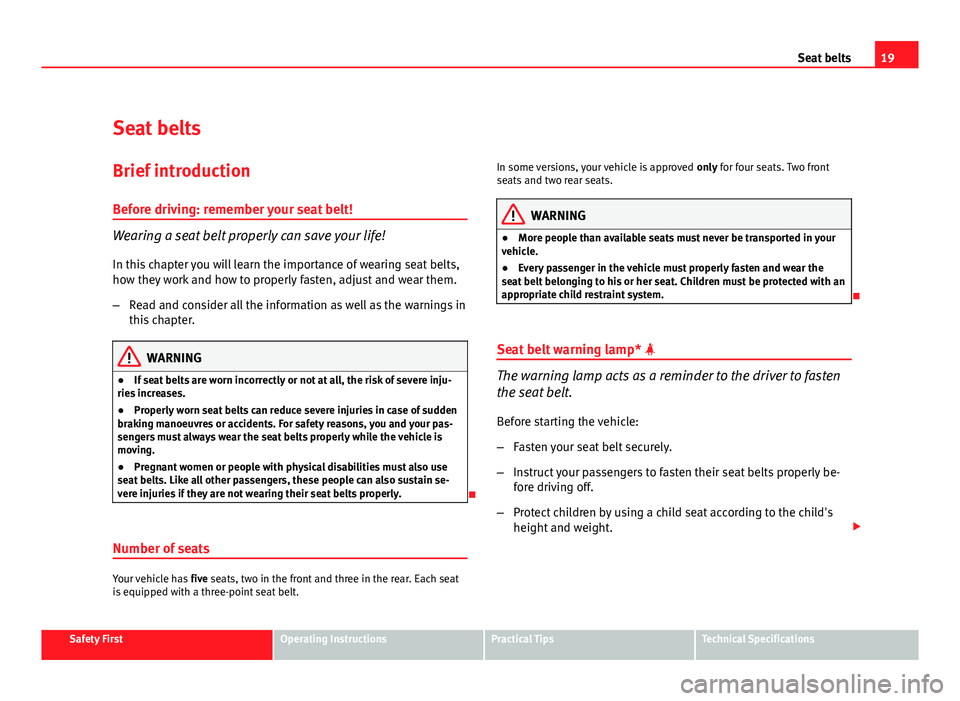
19
Seat belts
Seat belts
Brief introduction Before driving: remember your seat belt!
Wearing a seat belt properly can save your life!
In this chapter you will learn the importance of wearing seat belts,
how they work and how to properly fasten, adjust and wear them.
– Read and consider all the information as well as the warnings in
this chapter.
WARNING
● If seat belts are worn incorrectly or not at all, the risk of severe inju-
ries increases.
● Properly worn seat belts can reduce severe injuries in case of sudden
braking manoeuvres or accidents. For safety reasons, you and your pas-
sengers must always wear the seat belts properly while the vehicle is
moving.
● Pregnant women or people with physical disabilities must also use
seat belts. Like all other passengers, these people can also sustain se-
vere injuries if they are not wearing their seat belts properly.
Number of seats
Your vehicle has five seats, two in the front and three in the rear. Each seat
is equipped with a three-point seat belt. In some versions, your vehicle is approved
only for four seats. Two front
seats and two rear seats.
WARNING
● More people than available seats must never be transported in your
vehicle.
● Every passenger in the vehicle must properly fasten and wear the
seat belt belonging to his or her seat. Children must be protected with an
appropriate child restraint system.
Seat belt warning lamp*
The warning lamp acts as a reminder to the driver to fasten
the seat belt.
Before starting the vehicle:
– Fasten your seat belt securely.
– Instruct your passengers to fasten their seat belts properly be-
fore driving off.
– Protect children by using a child seat according to the child's
height and weight.
Safety FirstOperating InstructionsPractical TipsTechnical Specifications
Page 22 of 297
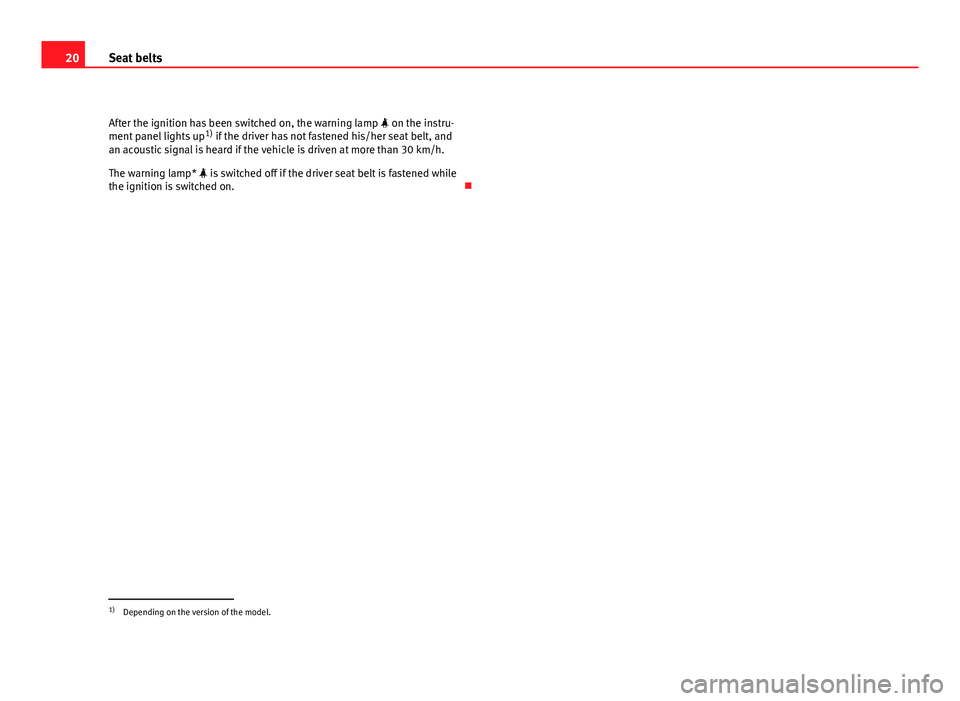
20Seat belts
After the ignition has been switched on, the warning lamp on the instru-
ment panel lights up 1)
if the driver has not fastened his/her seat belt, and
an acoustic signal is heard if the vehicle is driven at more than 30 km/h.
The warning lamp* is switched off if the driver seat belt is fastened while
the ignition is switched on.
1)
Depending on the version of the model.
Page 23 of 297

21
Seat belts
Why wear seat belts? Physical principles of frontal collisions
In the event of a frontal collision, a large amount of kinetic
energy must be absorbed.
Fig. 7 Vehicle about to
hit a wall: the occupants
are not wearing seat
belts
Fig. 8 The vehicle hits
the wall: the occupants
are not wearing seat
belts
It is easy to explain how the laws of physics work in the case of a head-on
collision: When a vehicle starts moving ⇒ fig. 7, a certain amount of energy
known as kinetic energy is produced in the vehicle and its occupants.
The amount of kinetic energy depends on the speed of the vehicle and the
weight of the vehicle and its passengers. The higher the speed and the
greater the weight, the more energy there is to be released in an accident.
The most significant factor, however, is the speed of the vehicle. If the
speed doubles from 25 km/h to 50 km/h, for example, the kinetic energy is
multiplied by four.
Because the passengers in our example are not restrained by seat belts, in
the case of a head-on collision all of their kinetic energy has to be absorbed
at the point of impact ⇒ fig. 8.
Even at speeds of 30 km/h to 50 km/h, the forces acting on bodies in a col-
lision can easily exceed one tonne (1000 kg). At greater speed these forces
are even higher.
Passengers not wearing seat belts are not “attached” to the vehicle. In a
head-on collision, they will move forward at the same speed their vehicle
Safety FirstOperating InstructionsPractical TipsTechnical Specifications
Page 24 of 297

22Seat belts
was travelling just before the impact. This example applies not only to
head-on collisions, but to all accidents and collisions.
The danger of not using the seat belt
The general belief that the passengers can protect them-
selves with their hands in a minor collision is false.
Fig. 9 A driver not wear-
ing a seat belt is thrown
forward violently.
Fig. 10 The unbelted
rear passenger is thrown
forward violently, hitting
the driver wearing a seat
belt.
Even at low speeds the forces acting on the body in a collision are so great
that it is not possible to brace oneself with one's hands. In a frontal colli-
sion, unbelted passengers are thrown forward and will make violent contact
with the steering wheel, dash panel, windscreen or whatever else is in the
way ⇒ fig. 9.
The airbag system is not a substitute for seat belts. When triggered, airbags
provide only additional protection. All occupants (including the driver) must
wear seat belts properly during the trip. This will reduce the risk of severe
injuries in the event of an accident – regardless of whether an airbag is fit-
ted for the seat or not.
Note that airbags can be triggered only once. To achieve the best possible
protection, the seat belt must always be worn properly so that you will be
protected in accidents in which no airbag is deployed.
It is also important for the rear passengers to wear seat belts properly, as
they could otherwise be thrown forward violently in an accident. Rear pas-
sengers who do not use seat belts endanger not only themselves but also
the front occupants ⇒ fig. 10.
Page 25 of 297

23
Seat belts
Seat belt protection
Passengers not wearing seat belts risk severe injuries in the
event of an accident.
Fig. 11 A driver wearing
the seat belt properly is
secured by the belt in
sharp braking
Properly worn seat belts hold the vehicle occupants in the correct sitting po-
sitions and substantially reduce the kinetic energy in the event of an acci-
dent. Seat belts also help to prevent uncontrolled movements that could
lead to severe injuries. In addition, properly worn seat belts reduce the dan-
ger of being thrown from the vehicle.
Passengers wearing their seat belts correctly benefit greatly from the ability
of the belts to absorb kinetic energy. The front part of your vehicle and other
passive safety features (such as the airbag system) are also designed to ab-
sorb the kinetic energy released in a collision. Taken together, all these fea-
tures reduce the releasing kinetic energy and consequently, the risk of in-
jury.
Our examples describe frontal collisions. Of course, properly worn seat belts
substantially reduce the risk of injury in all other types of accidents. This is
why it is so important to fasten seat belts before every trip, even when "just
driving around the corner". Ensure that your passengers wear their seat belts as well. Accident statistics
have shown that wearing seat belts is an effective means of substantially
reducing the risk of injury and improving the chances of survival in a seri-
ous accident. Furthermore, properly worn seat belts improve the protection
provided by airbags in the event of an accident. For this reason, wearing a
seat belt is required by law in most countries.
Although your vehicle is equipped with airbags, the seat belts must be fas-
tened and worn. The front airbags, for example, are only triggered in some
frontal accidents. The front airbags will not be triggered during minor frontal
collisions, minor side collisions, rear collisions, overturns or accidents in
which the airbag trigger threshold value in the control unit is not exceeded.
Therefore, you should always wear your seat belt and ensure that your pas-
sengers have fastened their seat belts properly before you drive off!
Safety instructions on using seat belts
If seat belts are used correctly, they can reduce the risk of in-
jury in an accident.
– Always wear the seat belt as described in this section.
– Ensure that the seat belts can be fastened at all times and are
not damaged.
Safety FirstOperating InstructionsPractical TipsTechnical Specifications
Page 26 of 297
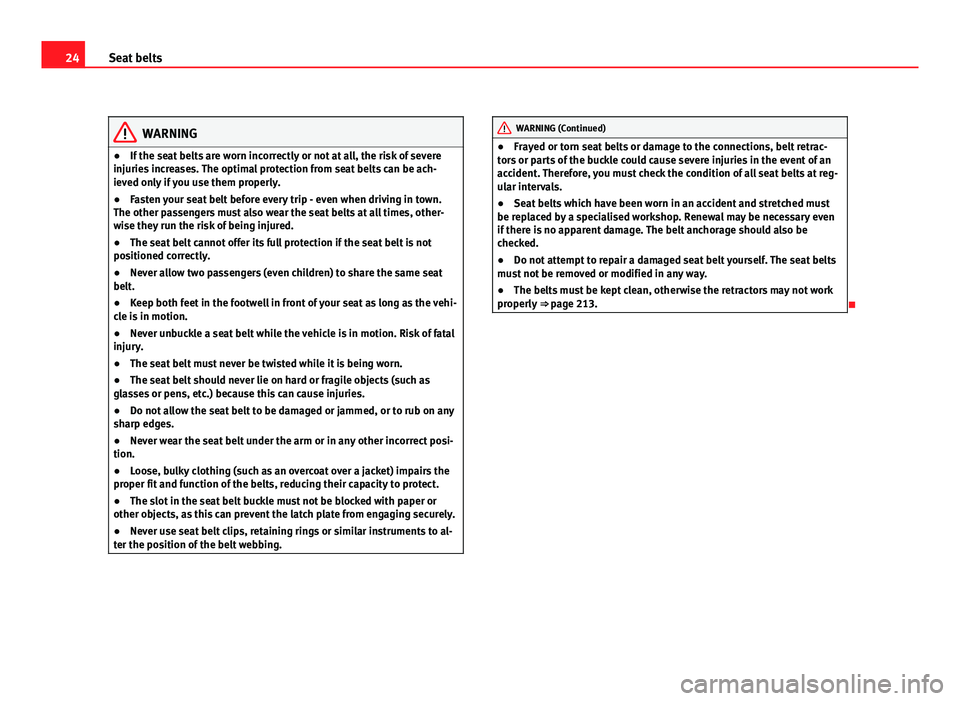
24Seat belts
WARNING
● If the seat belts are worn incorrectly or not at all, the risk of severe
injuries increases. The optimal protection from seat belts can be ach-
ieved only if you use them properly.
● Fasten your seat belt before every trip - even when driving in town.
The other passengers must also wear the seat belts at all times, other-
wise they run the risk of being injured.
● The seat belt cannot offer its full protection if the seat belt is not
positioned correctly.
● Never allow two passengers (even children) to share the same seat
belt.
● Keep both feet in the footwell in front of your seat as long as the vehi-
cle is in motion.
● Never unbuckle a seat belt while the vehicle is in motion. Risk of fatal
injury.
● The seat belt must never be twisted while it is being worn.
● The seat belt should never lie on hard or fragile objects (such as
glasses or pens, etc.) because this can cause injuries.
● Do not allow the seat belt to be damaged or jammed, or to rub on any
sharp edges.
● Never wear the seat belt under the arm or in any other incorrect posi-
tion.
● Loose, bulky clothing (such as an overcoat over a jacket) impairs the
proper fit and function of the belts, reducing their capacity to protect.
● The slot in the seat belt buckle must not be blocked with paper or
other objects, as this can prevent the latch plate from engaging securely.
● Never use seat belt clips, retaining rings or similar instruments to al-
ter the position of the belt webbing.WARNING (Continued)
● Frayed or torn seat belts or damage to the connections, belt retrac-
tors or parts of the buckle could cause severe injuries in the event of an
accident. Therefore, you must check the condition of all seat belts at reg-
ular intervals.
● Seat belts which have been worn in an accident and stretched must
be replaced by a specialised workshop. Renewal may be necessary even
if there is no apparent damage. The belt anchorage should also be
checked.
● Do not attempt to repair a damaged seat belt yourself. The seat belts
must not be removed or modified in any way.
● The belts must be kept clean, otherwise the retractors may not work
properly ⇒ page 213.
Page 27 of 297
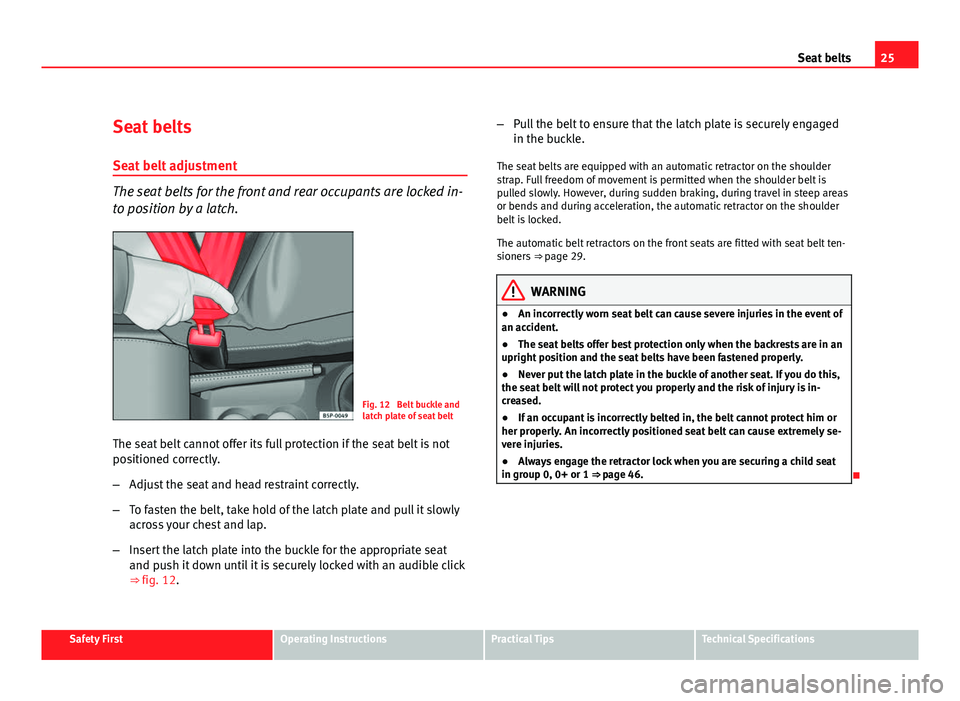
25
Seat belts
Seat belts
Seat belt adjustment
The seat belts for the front and rear occupants are locked in-
to position by a latch.
Fig. 12 Belt buckle and
latch plate of seat belt
The seat belt cannot offer its full protection if the seat belt is not
positioned correctly.
– Adjust the seat and head restraint correctly.
– To fasten the belt, take hold of the latch plate and pull it slowly
across your chest and lap.
– Insert the latch plate into the buckle for the appropriate seat
and push it down until it is securely locked with an audible click
⇒ fig. 12. –
Pull the belt to ensure that the latch plate is securely engaged
in the buckle.
The seat belts are equipped with an automatic retractor on the shoulder
strap. Full freedom of movement is permitted when the shoulder belt is
pulled slowly. However, during sudden braking, during travel in steep areas
or bends and during acceleration, the automatic retractor on the shoulder
belt is locked.
The automatic belt retractors on the front seats are fitted with seat belt ten-
sioners ⇒ page 29.
WARNING
● An incorrectly worn seat belt can cause severe injuries in the event of
an accident.
● The seat belts offer best protection only when the backrests are in an
upright position and the seat belts have been fastened properly.
● Never put the latch plate in the buckle of another seat. If you do this,
the seat belt will not protect you properly and the risk of injury is in-
creased.
● If an occupant is incorrectly belted in, the belt cannot protect him or
her properly. An incorrectly positioned seat belt can cause extremely se-
vere injuries.
● Always engage the retractor lock when you are securing a child seat
in group 0, 0+ or 1 ⇒ page 46.
Safety FirstOperating InstructionsPractical TipsTechnical Specifications
Page 28 of 297

26Seat belts
Seat belt position
Seat belts offer their maximum protection only when they
are properly positioned.
Fig. 13 Correct seat belt
and head restraint posi-
tions, viewed from front
Fig. 14 Correct seat belt
and head restraint posi-
tions, viewed from side The following features are available to adjust the seat belt in the shoulder
region:
●
belt height adjustment for the front seats.
● front seat height adjustment*.
WARNING
● An incorrectly worn seat belt can cause severe injuries in the event of
an accident.
● The shoulder part of the seat belt must lie on the centre of the shoul-
der, never across the neck. The seat belt must lie flat and snugly on the
torso ⇒ fig. 13.
● The lap part of the seat belt must lie across the pelvis, never across
the stomach. The seat belt must lie flat and snugly on the pelvis
⇒ fig. 14. Pull the belt tight if necessary to take up any slack.
● Read and observe the warnings ⇒ page 23.
Page 29 of 297
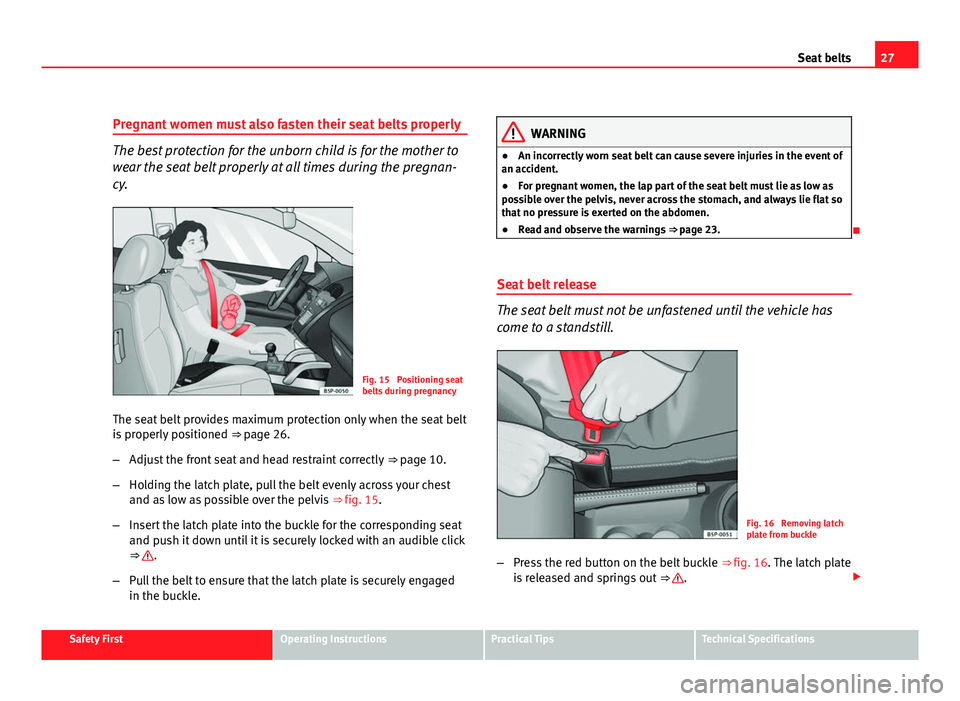
27
Seat belts
Pregnant women must also fasten their seat belts properly
The best protection for the unborn child is for the mother to
wear the seat belt properly at all times during the pregnan-
cy.
Fig. 15 Positioning seat
belts during pregnancy
The seat belt provides maximum protection only when the seat belt
is properly positioned ⇒ page 26.
– Adjust the front seat and head restraint correctly ⇒ page 10.
– Holding the latch plate, pull the belt evenly across your chest
and as low as possible over the pelvis ⇒ fig. 15.
– Insert the latch plate into the buckle for the corresponding seat
and push it down until it is securely locked with an audible click
⇒
.
– Pull the belt to ensure that the latch plate is securely engaged
in the buckle.
WARNING
● An incorrectly worn seat belt can cause severe injuries in the event of
an accident.
● For pregnant women, the lap part of the seat belt must lie as low as
possible over the pelvis, never across the stomach, and always lie flat so
that no pressure is exerted on the abdomen.
● Read and observe the warnings ⇒ page 23.
Seat belt release
The seat belt must not be unfastened until the vehicle has
come to a standstill.
Fig. 16 Removing latch
plate from buckle
– Press the red button on the belt buckle ⇒ fig. 16. The latch plate
is released and springs out ⇒
.
Safety FirstOperating InstructionsPractical TipsTechnical Specifications
Page 30 of 297

28Seat belts
–Guide the belt back by hand so that it rolls up easily and the
trim is not damaged
WARNING
Never unbuckle a seat belt while the vehicle is in motion. If you do, you
increase the risk of sustaining severe or fatal injuries.
Adjusting the seat belt height
Seat belt height adjusters can be used to adjust the position
of the seat belt at the shoulder.
Fig. 17 Location of the
belt height adjuster
The seat belt adjuster for the front seats can be used to adjust the
proper belt position at the shoulder.
– Press the upper part of the shoulder belt guide and hold it in
this position ⇒ fig. 17. –
Move the shoulder belt guide up or down until you have adjus-
ted the seat belt ⇒ page 26.
– After adjusting, pull the shoulder belt sharply to check that the
catch on the shoulder belt guide is engaged securely.
Incorrectly fastened seat belts
Incorrectly worn seat belts can cause severe or even mortal
injuries. Seat belts can provide optimal protection only if the belt web is
properly worn. The seat belts must be fastened exactly in the order
described in this chapter. An incorrect sitting position impairs sub-
stantially the protection a seat belt offers and can lead to severe or
fatal injuries. The risk of severe or fatal injuries is especially in-
creased when a deploying airbag strikes an occupant who has as-
sumed an incorrect sitting position. As the driver, you are responsi-
ble for all vehicle occupants, especially children. Therefore:
– Never allow anyone to wear the seat belt incorrectly while the
vehicle is moving ⇒
.
WARNING
● An incorrectly worn seat belt increases the risk of severe injuries.
● Before every trip, instruct your passengers to adjust their seat belts
properly and to wear them for the whole journey.
● Read and always observe information and warnings concerning the
use of seat belts ⇒ page 23.